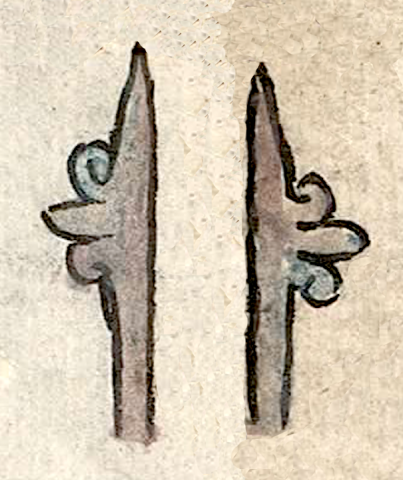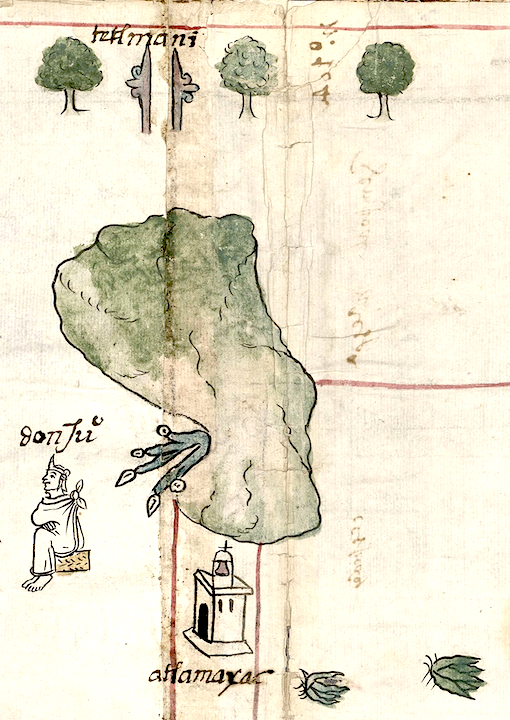Tetl Mani (CmpRG)
This is a compound glyph naming what appears to be a natural feature called Tetl Mani. It is found in the 1580 Relación Geográfica de Cempoala (originally Cempohuallan, and now Zempoala, Hidalgo). The glyph consists of a pair of two elongated, flat-bottomed rock/stone (tetl) and a verb that means, among other things, “to be, to be spread out" (mani). The rocks, which may be vertical or shown in a bird's eye view, are outlined in black and filled with brown pigment. Each has a typical, curling, three-lobed element that is a diagnostic for rocks and stones. The pairing of two rocks may be a semantic indicator that there are more than one such natural feature at this place.
Robert Haskett
The two, parallel rock elements of Tetl Mani appear on one edge of the map. This place may be a boundary marker for Cempohuallan’s territory made up of several distinctive rock formations. The compound glyph appears between two trees, but is not associated with the drawing of a church, a semantic element that would indicate an inhabited place (see the historical contextualizing image). For more information about the RG map, see Biblioteca Digital Mexicana, A.C., http://bdmx.mx/documento/mapas-relaciones-geograficas-cempoala-epazoyuca... Mundy, Barbara E., “Mapping Babel: A Sixteenth-Century Indigenous Map from Mexico,” The Appendix, 1:4 (October 2013), Mundy (1996), and Ballesteros García (2005), 75.
Robert Haskett
tetlmani
Tetl Mani
Robert Haskett
1580
Robert Haskett
rocks, stones, piedras, nombres de lugares

te(tl), rock, stone, https://nahuatl.wired-humanities.org/content/tetl
mani, to be spread out, to be elongated, https://nahuatl.wired-humanities.org/content/mani
las piedras se extienden (o, son alargadas)
Stephanie Wood and Robert Haskett
Relación de Cempoala - University of Texas Libraries Collections. 1580-11-01. https://collections.lib.utexas.edu/catalog/utblac:f87917e2-e3c9-4eb2-a83...
Materials that are in the public domain (such as most of the maps in the PCL Map Collection) are not copyrighted, and no permission is needed to copy them. You may download them and use them as you wish. The image appears here courtesy of the University of Texas Libraries, The University of Texas at Austin. If you do publish anything from this database, please cite the Visual Lexicon of Aztec Hieroglyphs.


